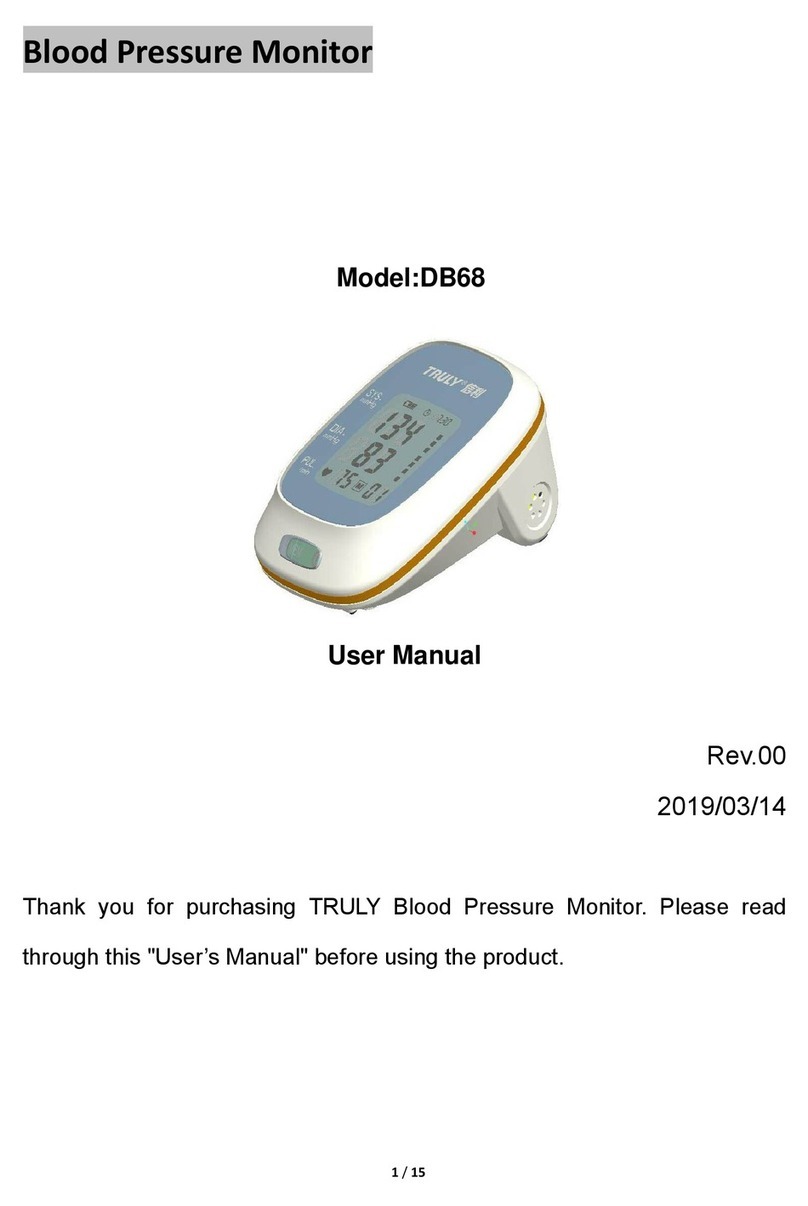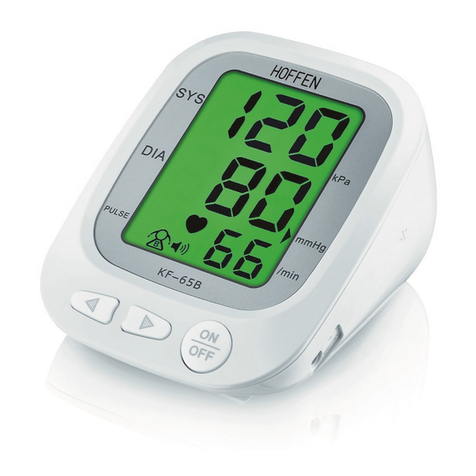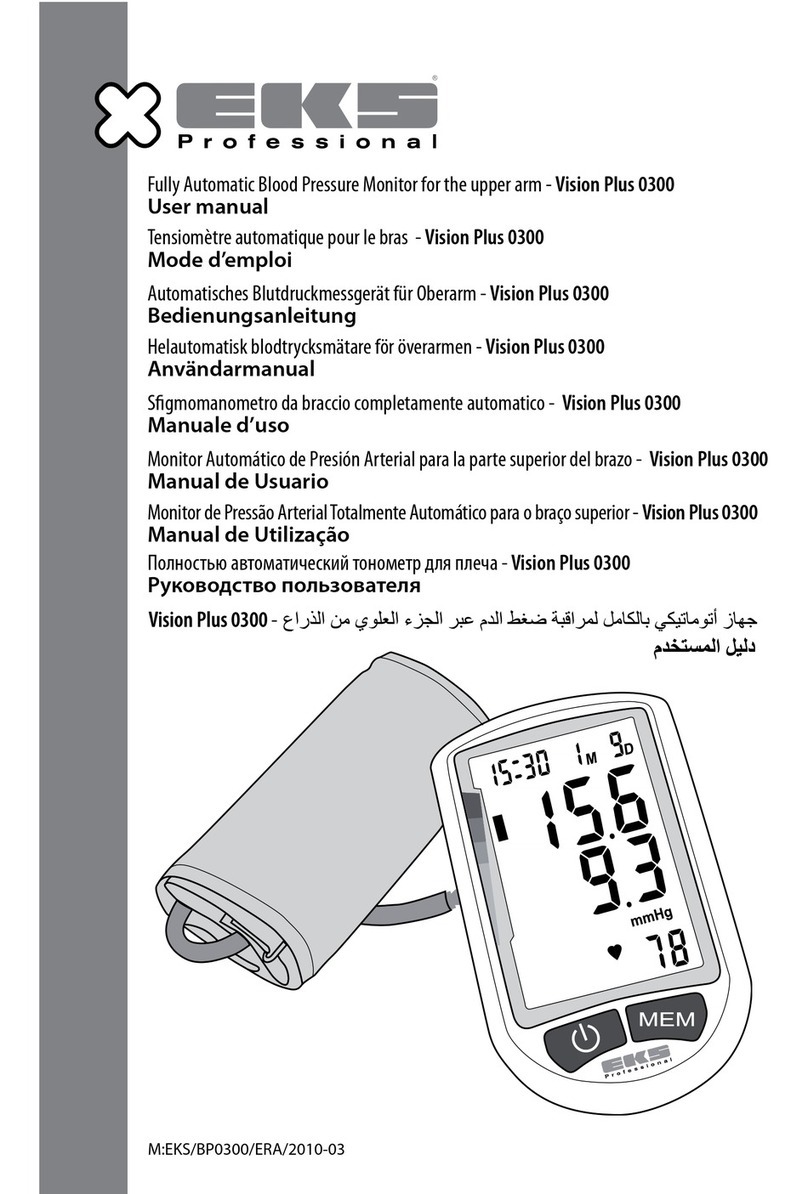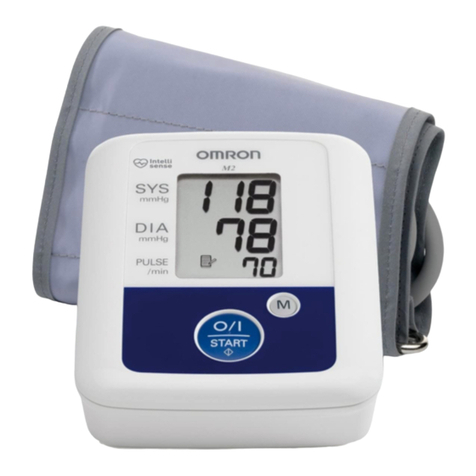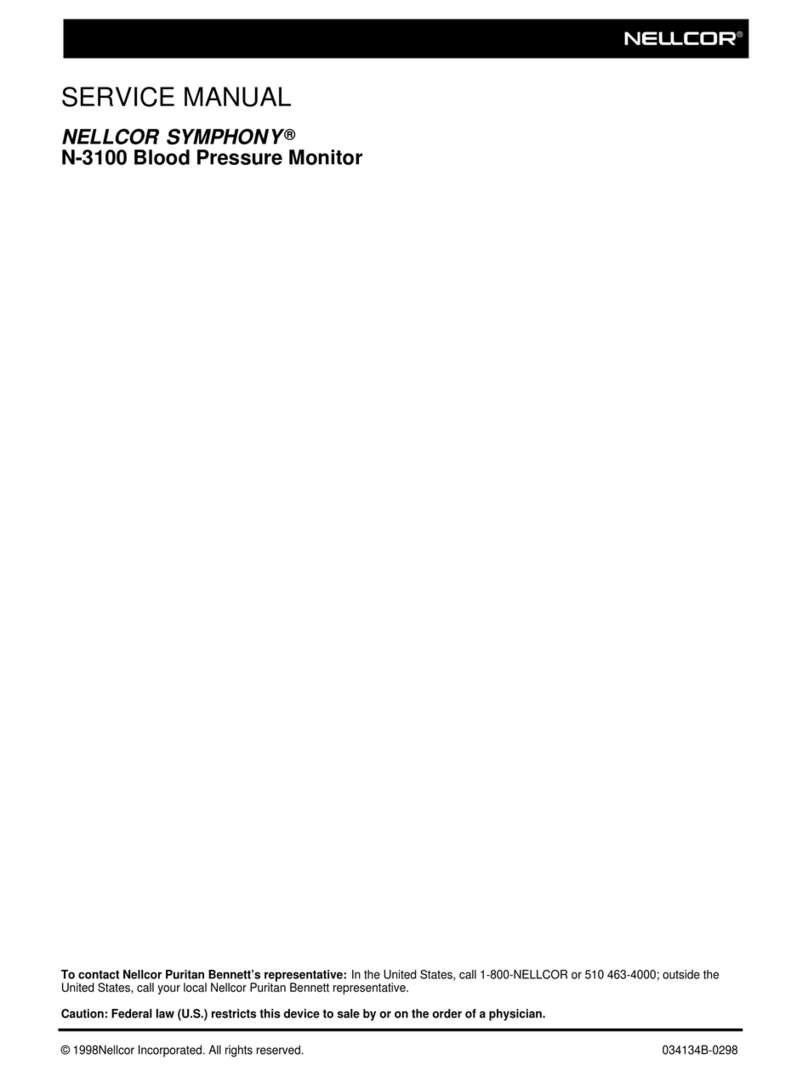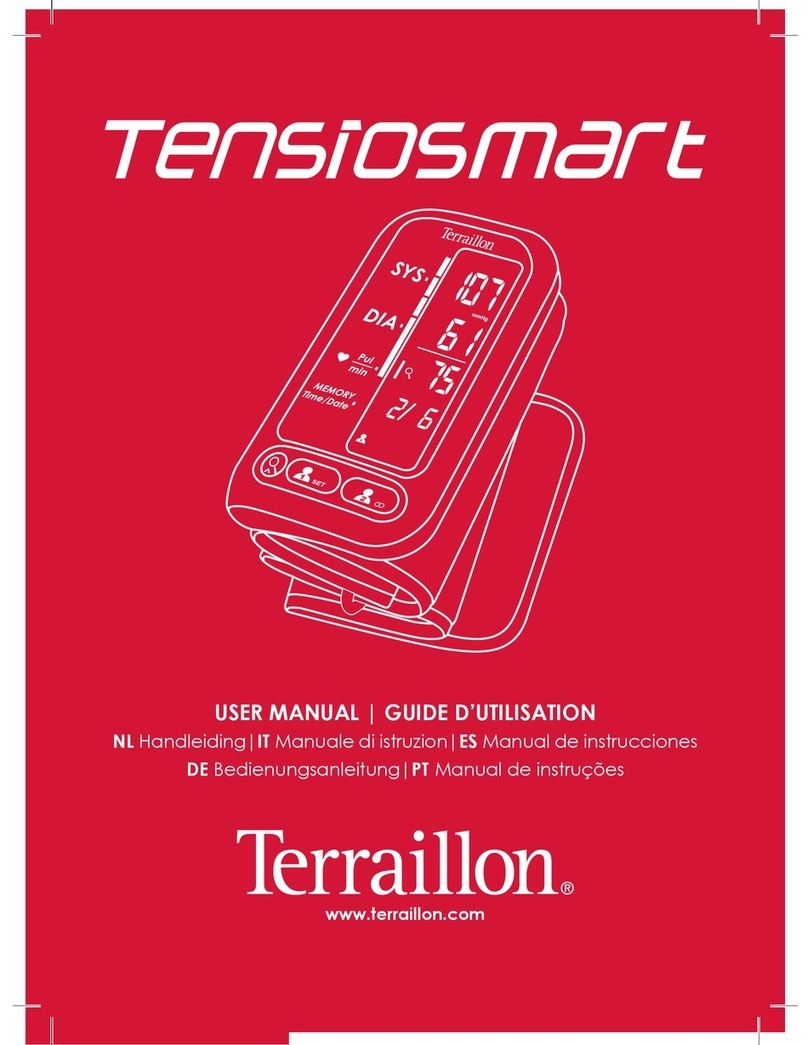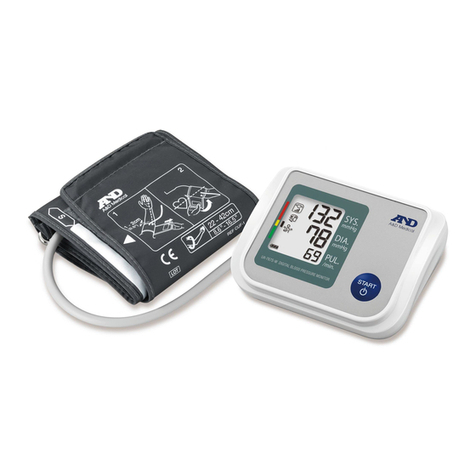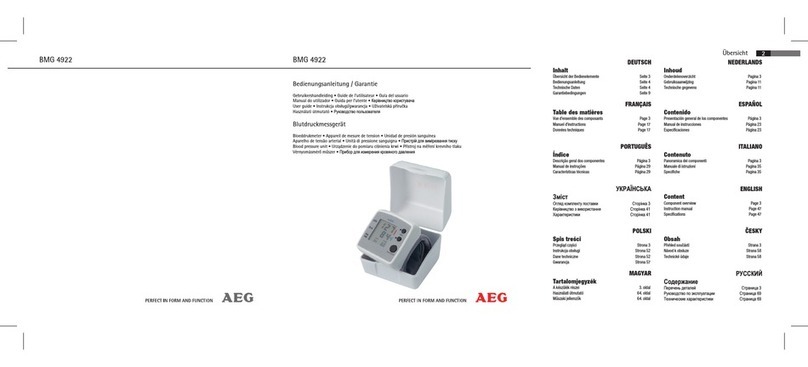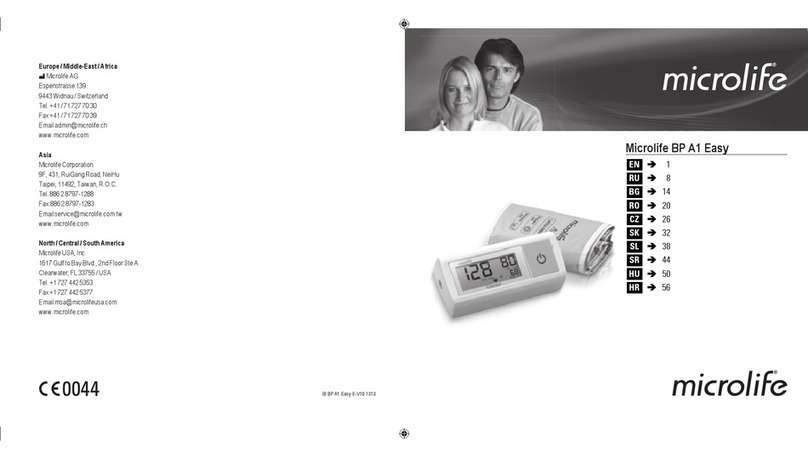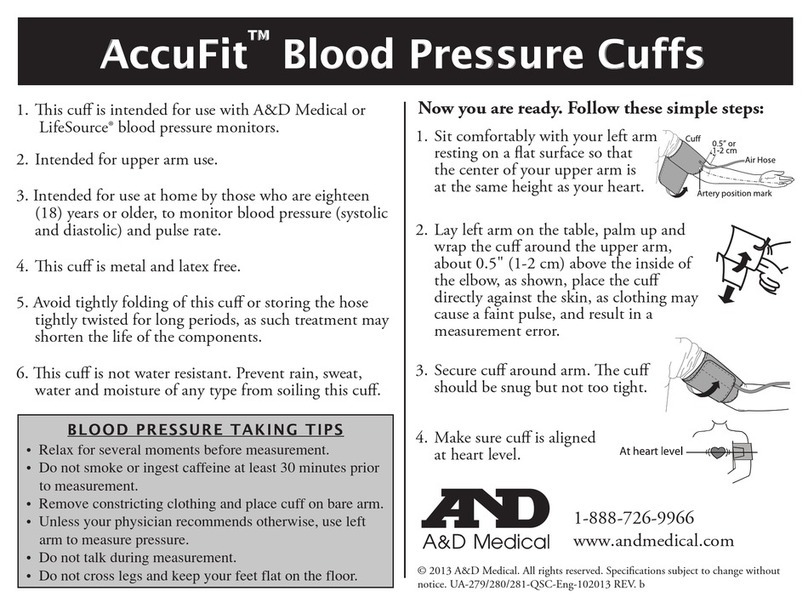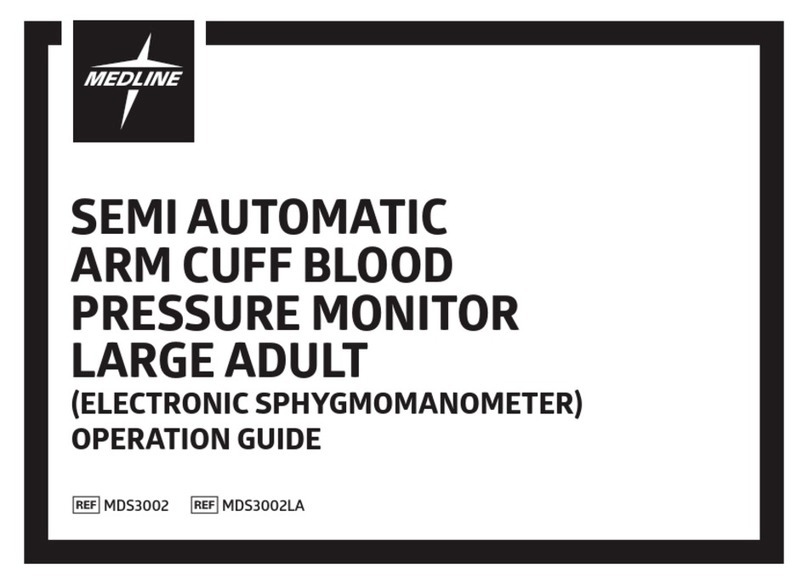EMPORIA B22 User manual

USER MANUAL
Digital upper arm bloodpressure monitor
Medical device - Class II A · Art. Nr.: BPM-V20-B · Modell: B22

02 ENGLISH
USER MANUAL · Art. Nr.: BPM-V20-B · Model: B22
›THANK YOU
for chosing an emporia blood pressure monitor. This blood pressure monitor offers
clinically proven accuracy and is designed to be easy to use. With the right care and
maintenance, your new blood pressure monitor will provide you with years of reliable
service. It is designed to measure blood pressure and pulse rate at home and deliver
consistent, reliable results.
Please read the following instructions and general information carefully, to ensure that
you get the best results from your new blood pressure monitor.
Stay healthy!

ENGLISH 03
›CONTENT
Introduction and intended use .......................................04
Comments..........................................................05
Warnings & precautions .............................................06
Important information on blood pressure and its measurement ........08
Construction of the blood pressure monitor...........................12
·Symbols on the LCD display ...........................................12
First use of the blood pressure monitor ...............................14
Measurement procedure ............................................16
·Before the measurement ..............................................16
·Common sources of error..............................................16
·Fitting the cuff........................................................17
·Measurement.........................................................18
·Recommendations during the measurement ...........................21
·Irregular Heartbeat Detector (IHB) .....................................21
·Error Indication .......................................................22
·Trouble shooting......................................................23
·Memory..............................................................24
·Viewing the stored values .............................................24
·Abort the measurement...............................................24
·Battery change indicator and power supply ............................25
Care & maintenance .................................................26
Quality control......................................................27
Technical specifications .............................................29
Symbol descriptions.................................................30
EMC Declaration ....................................................31

04 ENGLISH
USER MANUAL · Art. Nr.: BPM-V20-B · Model: B22
›INTRODUCTION AND INTENDED USE
These instructions are for the Model B22. It is a fully automatic, digital blood pressure
monitor for adults for private use. It allows very fast and reliable measurement of
systolic and diastolic blood pressure and pulse with the oscillometric Method. The
device has an irregular heart rate detector, a measured value memory for two users
and a three-colour scale showing the measurement result divide into the appropriate
group according to the World Health Organization (WHO). The enlarged cuff makes
it easy to use the device. The technology integrated into this blood pressure monitor
intelligently selects the amount of air that is pressed into the cuff, which minimizes the
pressure during the measurement. Read these instructions carefully and keep them for
future reference. Contact your doctor for more information about blood pressure and
blood pressure measurements, especially if you suspect your values are different from
the norm.
Warning: the product is not intended for newborns and young children.
Warning: this product is not intended for pregnant women.
Do not use the blood pressure monitor with high-frequency surgical equipment (HF).

ENGLISH 05
›COMMENTS
·Only a health-care-professional is qualified to interpret blood preasure
measurements.
·This device is NOT intended to replace regular medical checkups.
·Blood preassure readings obtained by this device should be verified by your doctor
before prescribing or making adjustments to any medications used to control
hypertension. Under no circumstances should YOU alter the dosages of any medicine
prescribed by your doctor
·This monitor is intended for use by adults only.
Consult with a doctor before using this instrument on a child.
·In cases of irregular heartbeat, measurements made with this instrument should only
be evaluated after consultation with your doctor.
Attention!
·This device contains sensitive electronic components. Avoid strong electrical or
electromagnetic fields in the direct vicinty of the device (e.g. mobile phones,
microwave ovens) during use. These can lead to incorrect results.
·Do not repair this device yourself. Should a malfunction occur, refer to local retailer.
Warning
1. Repetitive and over frequent use can cause injury to the patient due to blood flow
interference.
2. Do not place the cuff over a wound or injury.
3. During use, the pressure of the cuff can cause temporary loss of function to other
monitoring equipment that is being used on the same arm.
Contraindication
Use of this instrument on patients under dialysis therapy or on anticoagulant,
antiplatelets, or steroids could cause internal bleeding.

06 ENGLISH
USER MANUAL · Art. Nr.: BPM-V20-B · Model: B22
›WARNINGS & PRECAUTIONS
Warning: The device contains sensitive electronic components.
Avoid strong electrical or electromagnetic fields in the direct vicinity of the device
(e.g. mobile phones, microwave ovens).
These can lead to temporary impairment of the measuring accuracy.
Warning: Do not use cuffs, AC-adapters or batteries other than those included with
this product or replacement parts supplied by the manufacturer.
Warning: Do not use the batteries and the AC adapter to provide power at
the same time.
Warning: Remove the battery if the blood pressure monitor is not likely to be used for
some time.
Warning: No modification of this equipment is allowed
Warning: The device is not suitable for use in the presence of flammable anesthetic
mistures with air or with oxygen or nitrous oxide.
Caution: To avoid any possibility of accidental strangulation,
keep this unit away from children and do not drape tubing around your neck.
Caution: To avoid any damages of the device, keep it away from children and pets.
Caution: The standard material used for the the cuff and the tube is latex-free
Attention: Blood pressure measurement means self-monitoring and must not be a
reason for self-diagnosis or self-treatment. Unusual values must always be discussed
with your doctor. Under no circumstances should you alter the dosages of any drugs
prescribed by your doctor.

ENGLISH 07
Attention: The pulse rate is not suitable for checking the frequency of heart
pacemakers!
Attention: In cases of irregular heartbeat, measurements made with this blood
pressure monitor should only be evaluated after consultation with your doctor.
Note: To obtain the optimal accuracy from your blood pressure monitor, it is
recommended that is used within the specified temparature and the relative humidity,
as shown in: »Technical specifications« (page 29)
Attention: The cuff is a wearing part.
Contact the manufacturer for advice, troubleshooting or function settings of your
blood pressure monitor:
EMPORIA Telecom GmbH & Co. KG
customercare@emporia.at · www.emporia.eu · Industriezeile 36 · 4020 Linz · Austria
via email: customercare@emporia.at · via phone: or repairs, warranty claims
Mon.-Thu. 08:30a.m.-17:00 p.m. · Fri. 08:30a.m.-13:00 p.m.
Service hotline Germany +49 (0) 800 400 4711
Service hotline Austria +43 (0) 732 77 7717 446
Service hotline Switzerland +41 (0) 8484 50004
Service-Hotline Italy +39 (0) 93411 755645
Service hotline UK +44 (0)1923 947777
Service hotline Ireland +353 (0)1 592 6339
service@emporiatelecom.co.uk
Please have your proof of purchase ready.

08 ENGLISH
USER MANUAL · Art. Nr.: BPM-V20-B · Model: B22
›IMPORTANT INFORMATION ON BLOOD PRESSURE AND
ITS MEASUREMENT
How does high or low blood pressure arise?
Your level of blood pressure is determined in the circulatory center of the brain and
adjusts to a variety of situations through feedback from the nervous system. To adjust
blood pressure, the strength and speed of the heart (Pulse), as well as the width of
circulatory blood vessels is altered. Blood vessel width is controlled by fine muscles in
the blood vessel walls. You level of arterial blood pressure changes periodically during
heart activity: During the »blood ejection« (Systole) the value is highest (systolic blood
pressure value). At the end of the heart’s »rest period« (Diastole) pressure is lowest
(diastolic blood pressure value).Blood pressure values must lie within certain normal
ranges in order to prevent particular diseases.
Which values are normal?
Please refer to the diagram below
SEVERE HYPERTENSION
MODERATE HYPERTENSION
MILD HYPERTENSION
HIGH NORMAL VALUE
NORMAL BLOOD PRESSURE
OPTIMAL BLOOD
PRESSURE
(target value)
110
100
90
85
80
Diastolic blood
pressure (mmHg)
Systolic blood
pressure (mmHg)
120 130 140 160 180

ENGLISH 09
Druckklassifikation – Risikoindikator nach WHO
On the device display you will find six grids. Please refer to the table below.
The different grids represent the different interval scales of the World Health
Organization (WHO).
Blood pressure value
[SYS-systolic/DIA-diastolic] WHO grids WHO classifikation WHO clour
scale
SYS <120mmHg / DIA <80mm HG 1Optimal pressure
SYS <130mmHg / DIA <85mm HG 2Normal value
SYS <140mmHg / DIA <90mmHG 3High normal value
SYS <150 mmHg / DIA < 100mmHG 4Mild hypertension Yellow
SYS <180 mmHg / DIA <110mmHG 5Moderatehypertension
SYS ≥180 mmHg / DIA ≥110mmHG 6Severe hypertension RED
Warning: When the results of the systolic and diastolic blood pressure measurement
belong to different categories, the higher category is displayed.
·Blood pressure is very high if your diastolic pressure is above 90 mmHg and/or your
systolic blood pressure is over 160 mmHg, while at rest. In this case, please consult
your doctor immediately. Long-term values at this level endanger your health due to
continual damage to the blood vessels in your body.
·If your systolic blood pressure values are between 140 mmHg and 159mmHg and/
or the diastolic blood pressure values between 90 mmHg and 99mmHg, consult your
doctor. Regular self-checks are necessary.
·If you have blood pressure values that are too low, (i.e., systolic values under
105mmHg and/or diastolic values under 60mmHg), consult your doctor.
Even with normal blood pressure values, a regular self-check with your blood pressure
monitor is recommended. You can detect possible changes in your values early and

10 ENGLISH
USER MANUAL · Art. Nr.: BPM-V20-B · Model: B22
react appropriately.
·If you are undergoing medical treatment to control your blood pressure, keep a
record of values along with time of day and date. Show these values to your doctor.
Never use the results of your measurements to independently alter the drug doses
prescribed by your doctor.
Further information
·If your values are mostly normal under resting conditions but exceptionally high
under conditions of physical or psychological stress, it is possible that you are
suffering from so-called »labile hypertension«. Contact your doctor for a correct
assessment and diagnosis.
·Correctly measured diastolic blood pressure values above 120mmHg require
immediate medical attention, advice and treatment.
·At home, the measurement results are usually lower than in a hospital or a clinic.
At home you are more relaxed and calm.

ENGLISH 11
What can be done if regular high or low values are obtained?
1. Consult your doctor.
2. Increased blood pressure values (various forms of hypertension) are associated with
considerable health risks over time.
Arterial blood vessels in your body are endangered due to constriction caused by
deposits in the vessel walls (Arteriosclerosis).
Adeficient supply of blood to important organs (heart, brain, muscles)
can result from arteriosclerosis.
Furthermore, the heart will become structurally damaged with increased
blood pressure values.
3. There are many different causes of high blood preassure.
We differentiate between the common primary (essential) hypertension,
and secondary hypertension. The latter group can be ascribed to specific organ
malfunctions. Please consult your doctor for information about the possible origins of
your own increased blood pressure values.
4. There are measures which you can take to reduce and even prevent high
blood pressure. Contact your doctor about further informations.

MEM
STA RT
STOP
SET
1
5
7
6
2
3
4
1
11
8 9 10
6
4 5
3
7
12 13 14
2
12 ENGLISH
USER MANUAL · Art. Nr.: BPM-V20-B · Model: B22
›CONSTRUCTION OF THE BLOOD PRESSURE MONITOR
1. LCD display
2. SET button
3. START/STOP button
4. MEM button
5. Cuff-socket
6. AC-adapter port
7. Battery compartment
Symbols on the LCD display
1. Systolic blood pressure
(SYS)
2. Diastolic blood pressure
(DIA)
3. WHO colour scale
4. Irregular heartbeat
symbol (IHB)
5. Heartbeat symbol (flashes
during measurement)
6. Memory symbol
7. Pulse display
8. Date/Time display
9. Average value symbol
(AVG)
10. Cuff self checking
function
11. User A
12. User B
13. Movement error symbol
14. Battery low symbol

ENGLISH 13
Features of the blood pressure monitor
1. Memory of 2 users
with 120 measurements
2. Automatic control of
cuff alignment 3. Detection of Arrhythmia
4. Average result of the last
3 measurements 5. Display for low battery 6. WHO colour scale
7. Automatic switch-off 8. Connection possibility of the
AC adapter (optional) 9. Date and time display
10. Large, high-quality
acrylic LCD display

14 ENGLISH
USER MANUAL · Art. Nr.: BPM-V20-B · Model: B22
›FIRST USE OF THE BLOOD PRESSURE MONITOR
I. Activating the blood pressure monitor
Battery Installation
Use only 1.5V AAA alkaline batteries with this device.
1. You will find the battery compartment on the back of the blood pressure monitor.
To open, slide the cover down and remove it.
2. Install 4×AAA size batteries so the +(positive) and –(negative) polarities match the
polarities of the battery compartment. Close the battery compartment with the cover
and make sure that the cover is securely in position.
Battery replacement
Low Battery Indicator
1. When the Low Battery Indicator appears on the display , turn the blood pressure
monitor off and remove all the batteries. Replace the old batteries with 4 new ones.
Long-life alkaline batteries are recommended.
2. To prevent the damage of your blood pressure monitor from leaked battery fluid, please
take out the batteries if the monitor is unused for a longer period (generally more than
3 months). If battery fluid should get in your eyes, immediately rinse with plenty of clean
water and contact a doctor immediately.
3. Dispose the device, components and optional accessories according to applicable local
regulations. Unlawful disposal may cause environmental pollution.
4. Battery are dangerous goods, so do not mix it with other rubbish.
II. System Settings
After you load the batteries or connect an AC Adapter to the blood pressure monitor,
you can change the system setting by pressing and holding the SET button for more
than 3 seconds.

ENGLISH 15
Setting the User: Press the MEM button to select User A or User B.
When the display shows A (/B) on the screen, press the MEM button to switch to user B
(A). Press the SET button to confirm.
Setting the Year: When the year display flashes, press the MEM button.
The year is increased by 1 year at a time. As soon as the set year is correct,
press the SET button to confirm.
Setting Month/Day: The initial Month/Date is 1/01. When the month display is flashing,
press the MEM button and the month will increase by 1 keep pressing until the correct
month is displayed. Press the SET button to confirm and keep pressing until the correct
month is displayed the same way to set the day.
Setting Time: When the hour display is flashing, press the MEM button and
the hour will increase by 1 keep pressing until the desired hour is displayed.
Press the SET button to confirm, now repeat the process to set the minute and
press the SET key to confirm.
Record Delete: When you checking the memory data, press the MEM button for about
3 seconds to delete existing user measurement data.
Note: If you remove/change the batteries, the date and time must be set again.
The measurement data that is saved will be retained.
III. Cuff tube connection
Insert the cuff tube into the cuff socket on the left side of the device.

16 ENGLISH
USER MANUAL · Art. Nr.: BPM-V20-B · Model: B22
›MEASUREMENT PROCEDURE
Note: Sit down and relax before measuring. Place your feet flat on the floor and do not
cross your legs.
Before the measurement
·Avoid eating and smoking as well as all forms of exertion directly before measurement.
These factors influence the measurement result. Find time to relax by sitting in an
armchair and in a quiet atmosphere for about ten minutes before taking a measurement.
·Remove any garment that fits closely to your upper arm.
·Always measure on the same arm (normally left).
·Always compare measurements taken at the same time of day, since blood pressure
changes during the course of the day, as much as 20 -40 mmHg.
Common sources of error
Attention: Comparable blood pressure measurements always require the same conditions.
·Always measure in a relaxed state.
·Make sure you are in a comfortable, relaxed position and do not flex any of the
muscles in the arm during the measurement. Use a cushion for support if necessary.
·If the arm artery lies considerably lower or higher than the heart, an erroneously high
or low blood pressure will be measured! Each 25 -30cm difference in height between
your heart and the cuff results in a measurement error of 10mmHg!
The wide range rigid is 22-40 cm (8.7"-15.7").
Attention: Only use approved cuffs!
·A loose cuff can cause false measurement values.
·With repeated measurements, blood accumulates in the arm, which can lead to
false results. Consecutive blood pressure measurements should be repeated after a
1 minute pause or after your arm has been held up in order to allow the accumulated
blood to flow away.

ENGLISH 17
Fitting the cuff
1. The cuff is preformed for easier use.
Remove tight or bulky clothing from your upper arm.
2. Wrap the cuff around your left upper arm. The rubber tube should be on the inside of
your arm extending downward to your hand. Make certain the cufflies approximately
2-3cm (½" to ¾") above the elbow.
Important: The on the edge of the cuff [Artery Mark] must lie over the artery which
runs down the inner side of the armmust lie over the artery which runs down the inner side
of the arm.
3. To secure the cuff, wrap it around your arm and secure the cuff using the velcro.
4. There should be little space between your arm and the cuff. You should be able to put
2 fingers between your arm and the cuff. Cuffs that don't fit properly result in false
measurement values.
5. Lay your arm on a table (palm upward) so the cuff is at the same height as your heart.
Make sure the tube is not kinked.
6. Remain silent and relaxed for at least two minutes before you begin the measurement.

18 ENGLISH
USER MANUAL · Art. Nr.: BPM-V20-B · Model: B22
Measurement
The blood pressure monitor is designed to take measurements and store the
measurement values in memory for two people using User ID A and User ID B.
·Sit comfortably in a chair with your feet flat on the floor.
·Select your User ID (A or B). Stretch your arm forward on the desk and keep relaxing,
make sure the palm is upwards. Make sure your arm is in correct position and avoid
body movement. Sit still and do not talk or move during the measurement. After
the cuff has been appropriately positioned on the arm and connected to the blood
pressure monitor, the measurement can begin:
1. Press the START/STOP button. The pump begins to inflate the cuff.
2. After automatically reaching an individual pressure,
the pump stops and the pressure slowly decreases.
3. When the device has detected your pulse, the heart symbol in the display begins to flash.
4. When the measurement has been concluded, the measured systolic and diastolic
blood pressure values, as well as the pulse will be displayed.
5. The appearance of this symbol signifies that an irregular heartbeat was detected.
This indicator is only a caution. It is important that you are relaxed, remain still and do

ENGLISH 19
not talk during measurements.
6. The measurement results are displayed until you switch the device off.
If no buttons is pressed for 60 seconds, the device switches off automatically.
7. A rest period of 15 seconds must be observed between each measurement.
If an error message is displayed during the measurement, the measurement will be
repeated. If an additional error occurs, the measurement is interrupted and an error
code is displayed.
8. The cuff correct symbol ( ) will be displayed iif the cuff position is correct,
otherwise the symbol ( ) for wrong positioning will be displayed.
9. The Movement Error Symbol ( ) is displayed if you move your body during the
measurement. Please remove the cuff and wait 2-3 minutes. Reapply the cuff and
take another measurement.

20 ENGLISH
USER MANUAL · Art. Nr.: BPM-V20-B · Model: B22
Correct position during measurement
1. Comfortably seated
2. Legs uncrossed
3. Feet flat on the floor
4. Back and arm supported
5. Cuff at the level of the heart
High difference
between the table and
the chair 25 -30 cm.
Upper arm is
not covered
by any cloth
Cuff and the heart are
the same level.
Relax the hand and
palm is upwards
This manual suits for next models
1
Table of contents
Other EMPORIA Blood Pressure Monitor manuals

